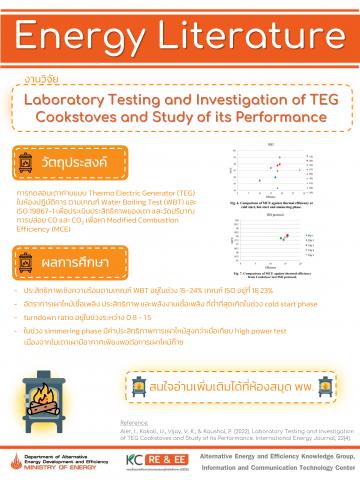Laboratory Testing and Investigation of TEG Cookstoves and Study of its Performance
Laboratory Testing and Investigation of TEG Cookstoves and Study of its Performance
Abstract
Laboratory testing of TEG cookstove is conducted with eucalyptus fuelwood following the testing protocols WBT 4.2.3 and ISO 19867-1 to evaluate the performance of the stove and CO and CO2 emissions were measured to obtain the values of modified combustion efficiency. The performance results were analysed in terms of thermal efficiency, firepower, turndown ratio and specific energy consumption. It was found that the thermal efficiency conducted by WBT resulted in the range 15-24% while ISO protocol testing was 18.23%. The experimental results found the least fuel burning rate, efficiency, and firepower during the cold start phase of the experiment. The duration of the simmering phase was nearly 2-3 times more than the duration of the hot-start phase while the turndown ratio was in the range of 0.8 to 1.5 which concluded that higher specific fuel consumption and lower thermal efficiency was a consequence of higher power output, or an inability to turn down the stove power. Higher value of MCE was calculated during simmering phase compared to high power tests due to availability of sufficient air to combust the gases in the combustion chamber.
Reference: Aier, I., Kakati, U., Vijay, V. K., & Kaushal, P. (2022). Laboratory Testing and Investigation of TEG Cookstoves and Study of its Performance. International Energy Journal, 22(4).
บทคัดย่อ
การทดสอบเตาถ่านแบบ Thermo Electric Generator (TEG) ในห้องปฏิบัติการด้วยฟืนยูคาลิปตัส ตามเกณฑ์การทดสอบการเดือดของน้ำ Water Boiling Test (WBT) และ ISO 19867-1 เพื่อประเมินประสิทธิภาพของเตา และวัดปริมาณการปล่อย CO และ CO2 เพื่อหาประสิทธิภาพในการเผาไหม้ (modified combustion efficiency) ซึ่งประสิทธิภาพของเตาได้ถูกวิเคราะห์ในแง่ของประสิทธิภาพเชิงความร้อน (thermal efficiency) พลังงานเชื้อเพลิง (firepower) อัตราส่วนระหว่างการเผาไหม้สูงสุดและการเผาไหม้ต่ำสุด (turndown ratio) และค่าการใช้พลังงานจําเพาะ (specific energy consumption) ผลการทดสอบพบว่า ประสิทธิภาพเชิงความร้อนตามเกณฑ์ WBT อยู่ในช่วง 15-24% ในขณะที่การทดสอบตามเกณฑ์ ISO อยู่ที่ 18.23% อีกทั้ง อัตราการเผาไหม้เชื้อเพลิง ประสิทธิภาพ และพลังงานเชื้อเพลิง ที่ต่ำที่สุดเกิดในช่วงที่เตาเย็น (cold start phase) ระยะเวลาในช่วงที่มีพลังงานต่ำ (simmering phase) ยาวนานกว่าระยะเวลาช่วงที่เตาร้อน (hot-start phase) เกือบ 2-3 เท่า ในขณะที่ turndown ratio อยู่ในช่วงระหว่าง 0.8 - 1.5 ซึ่งทำให้สามารถสรุปได้ว่า เมื่อผลิตพลังงานมากขึ้นหรือไม่สามารถลดกำลังไฟในเตาลงได้ ค่าพลังงานจำเพาะจะสูงขึ้นและประสิทธิภาพเชิงความร้อนจะลดลง นอกจากนี้ ในช่วง simmering phase มีค่าประสิทธิภาพการเผาไหม้สูงกว่าเมื่อเทียบกับการทดสอบพลังงานสูง (high power test) เนื่องจากในเตาเผามีอากาศเพียงพอต่อการเผาไหม้ก๊าซ
https://kc.dede.go.th/knowledge-view.aspx?p=352

